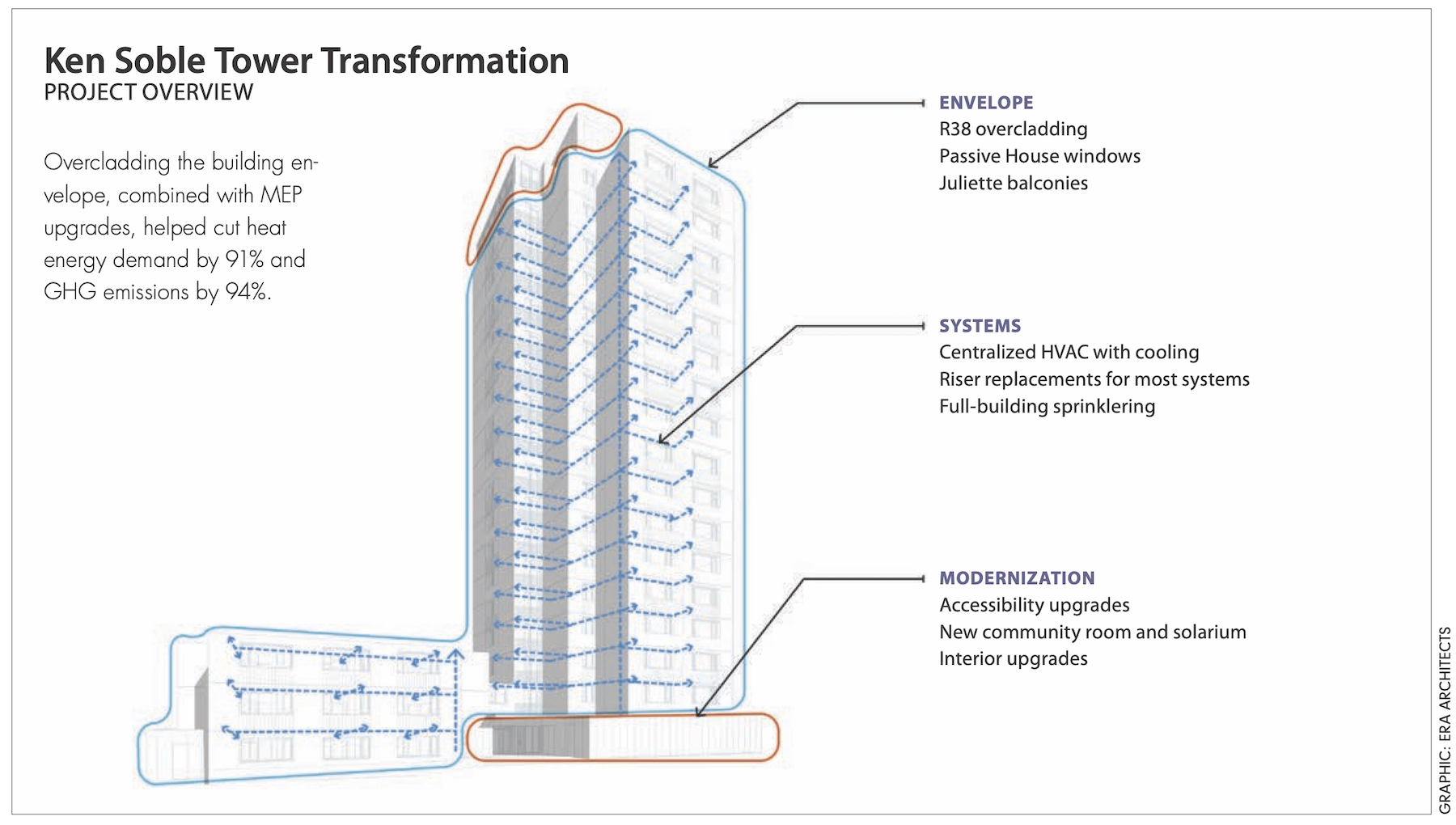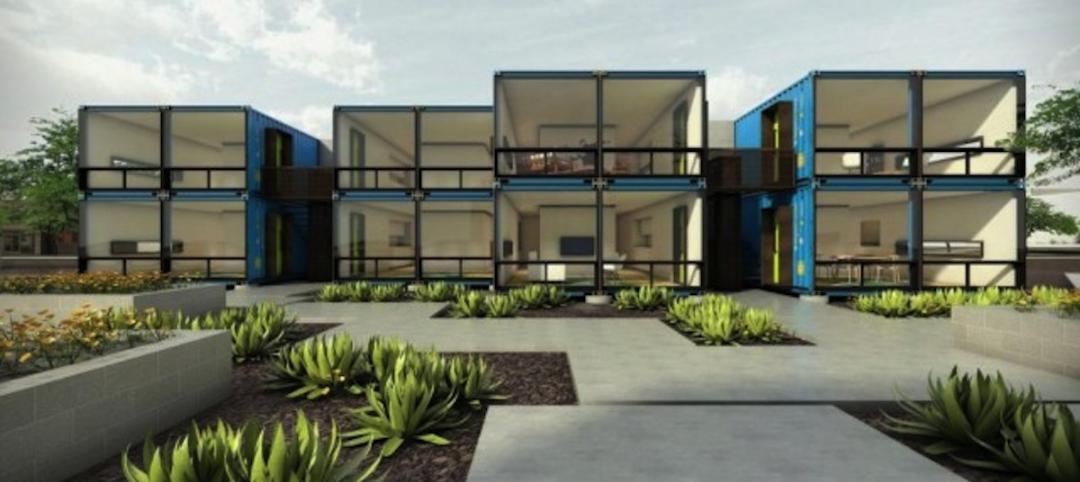Ken Soble Tower, an affordable housing high-rise for seniors in Hamilton, Ont., is now arguably the world’s largest residential building retrofitted to the Passive House standard.
Led by ERA Architects and PCL Construction, the project team slashed the 80,000-sf, 18-story building’s greenhouse gas emissions by 94% and its heating energy demand by 91% en route to achieving EnerPHit certification. The total energy needed to heat and cool one of its 146 units is now equivalent to that needed to power three 100-watt light bulbs.
Built in 1967 as part of the “North End Renewal” of West Harbour, an industrial neighborhood on Lake Ontario, the tower and an accompanying three-story walkup provided one-bedroom and bachelor apartments for families and single workingmen.
At the time, the complex, named after the founder of a local radio station and a local TV station, was considered a showcase property in the portfolio of CityHousing Hamilton, the municipal housing authority.
By 2012, however, the property was showing its age. The elevators constantly failed; so, too, the heating and cooling system. Mold, peeling paint, and water damage were apparent everywhere.
Worst of all: the pest problem. Forty-two percent of maintenance calls were for cockroaches, rodents, and bedbugs. The bedbug infestation was so bad the housing agency had to move whole floors of tenants to temporary housing on the 16th floor while crews tried to kill the critters. The bedbugs kept coming back.
The housing agency started relocating tenants. In less than four years, two-thirds of the apartments in Ken Soble Tower were vacant, despite a citywide waitlist of 6,000 families seeking affordable housing.

In 2015, CityHousing Hamilton, which manages 7,000 apartments in 1,265 properties, for 13,000 residents, surveyed the tower’s remaining residents about the future of the property; 83% responded. Their message to the agency: “Keep Ken Soble Tower.” A year later, the financial consulting firm Deloitte, acting on behalf of CityHousing Hamilton, studied the options—sell, demolish and rebuild, perform basic capital repairs, or refurbish—and came to the same conclusion: renovate.
The housing agency gave the go-ahead to completely retrofit Ken Soble Tower, a project that became part of Canada’s National Housing Strategy to modernize and decarbonize older affordable apartments. The project was folded into the Tower Renewal Partnership, an initiative by the nonprofit Centre for Urban Growth and Renewal (cugr.ca) to transform Southern Ontario’s stock of post-war apartment towers into more healthy, resilient, and complete communities.
A FIVE-PRONGED APPROACH TO RESTORATION
The renewal effort had five objectives:
- Modernize all 146 dwelling units.
- Attain EnerPHit certification, based on 2050 temperature projections, to cut GHG emissions by 94% and energy intensity by 70%.
- Allow for aging-in-place, by creating 31 barrier-free residences and reconfiguring elevators, doorways, and residential garbage areas to allow for barrier-free movement throughout the building.
- Address the housing authority’s 30-year capital repair program.
- Maintain “deep affordability,” through Hamilton’s Rent Geared to Income subsidy.
The building envelope consisted of composite masonry walls with minimal interior insulation and vapor control layers; it was sorely deteriorated. The design team’s first thought was to build an entire wall assembly outside the brick. Instead, the team overcladded the structure: first, with a liquid-applied air barrier; followed by a DuROCK PUCCS NC noncombustible rainscreen EIFS system, which incorporated 50,000 sf of a six-inch-thick layer of Rockwool stone wool insulation into the façade; finally, a stucco finish. Another four inches of mineral wool was added to the interior.
The EIFS system helped the project realize the R-38 effectiveness required to achieve EnerPHit certification. The retrofit resulted in a 94% reduction in GHG emissions and a 91% cut in heating energy demand. In practical terms, it meant that the building would stay warm in winter for up to two days and below dangerous heat levels in summer for up to four days.
Concrete slab balconies were replaced with juliettes to meet maintenance and accessibility requirements and eliminate thermal bridging. Easily operable triple-glazed windows and doors were installed to encourage natural ventilation. The roof membranes and below-grade waterproofing were replaced with fluid-applied products and upgraded with up to 16 inches of insulation.
Mechanical systems were completely overhauled with new central systems that provide tempered fresh air to each suite from rooftop energy recovery ventilators (ERVs), and individual control with in-suite variable-air volume (VAV) dampers with reheat. Common areas are served by smaller ERVs that are activated by occupancy sensors. A sophisticated building automation system will measure and verify that all building systems are functioning as designed.
The project came in at $34 million ($233,000/unit), 70% of which was for base building renewal, 30% for low-energy initiatives.
COMPREHENSIVE AIR TIGHTNESS TESTING
To achieve EnerPHit certification from Passive House Canada, the team developed a comprehensive air tightness testing and quality management program, led by PCL’s in-house building envelope engineering and construction team. Final operational whole building air tightness tests came in at 0.235 air changes/hr at 50 pa, beating the target by more than 50%.
One novel effort was that all building trades’ foremen and supervisors participated in a Passive House trades training session, with a focus on airtightness and reducing thermal bridging.

“Social sustainability” also played a part in the retrofit program. A dingy laundry room on the 18th floor was turned into a solarium, with views of the harbor. High-contrast wayfinding and bright color palettes were added to support community cohesion. Higher delivery of fresh air directly to units and the selection of low-VOC interior finishes greatly improved indoor air quality.
Adding to its distinctions, the Ken Soble Tower will become a teaching laboratory. CityHousing Hamilton, the University of Toronto, ERA Architects, and PCL Construction will, over the next two years, measure the impacts of the building on its residents and the surrounding environment, including building performance, occupant health and safety, and economic benefit.
PROJECT TEAM | KEN SOBLE TOWER
Owner: CityHousing Hamilton
Lead Architect/Interiors/Landscape Design: ERA Architects
Structural Engineer/Building Envelope Consultant: Entuitive
Mechanical Engineer: Reinbold Engineering Group
Electrical Engineer: Nemetz (S/A) & Associates
Passive House Consultants: JMV Consulting; Transsolar
Passive House Certifier: Herz & Lang GmbH
Building Envelope Testing: Engineering Link
Commissioning Consultant: CFMS Consulting Inc.
Elevators: Soberman Engineering
Building Code Consultant: LMDG Security/Telecoms Zerobit
Construction Consultant: SCR Consulting
Construction Manager: PCL Construction
Related Stories
Multifamily Housing | Apr 9, 2015
Multifamily development and transactions haven’t taken a breather yet
Despite predictions about an impending softening in multifamily construction, builders and developers continue to expand their market reach and portfolios.
Multifamily Housing | Apr 8, 2015
Roof air leakage issues in multifamily buildings isn’t just 'hot air' talk
Paladino's Robert Hayes talks about venting regulations in New York and how air leaks can cost residents upwards of $3,000 a year.
Mixed-Use | Apr 7, 2015
$100 billion 'city from scratch' taking shape in Saudi Arabia
The new King Abdullah Economic City was conceived to diversify the kingdom's oil-dependent economy by focusing more in its shipping industry.
High-rise Construction | Apr 6, 2015
Melbourne tower will light up depending on weather
The tower will be illuminated by 164-foot-tall beams of LED light based on weather updates from the Bureau of Meteorology.
Multifamily Housing | Apr 2, 2015
Historic Cabrini Green church to be demolished for tech-focused multifamily development
The infamous neighborhood’s Saint Dominic’s Church “was instrumental in taming a part of the city that grew up from the swamps as a lawless district of vice and poverty,” according to the Chicago Architecture blog.
Modular Building | Mar 31, 2015
Phoenix apartment complex will be made from recycled shipping containers
The eight-unit complex, called Containers on Grand, was inspired by the need for affordable and sustainable housing near the city's core.
Multifamily Housing | Mar 31, 2015
Plans for a new condo tower in New York create a ‘communal ecosystem’ for residents
The conceptual plans for a 700-foot-tall, 65-story condominium tower in New York City were unveiled in early March by its architect, Perkins+Will.
Multifamily Housing | Mar 27, 2015
Bathroom fixtures get a starchitect makeover by Bjarke Ingels
This Danish starchitect elevates the toilet paper holder (and other bathroom accessories).
High-rise Construction | Mar 24, 2015
Timber high-rise residential complex will tower over Stockholm waterfront
The four towers, 20 stories each, will be made entirely out of Swedish pine, from frame to façade.
Multifamily Housing | Mar 24, 2015
High tech automation is one new condo development’s calling card
The Sterling Collection in Arizona will include the first robotic parking garage for a West-Coast residential community.
















